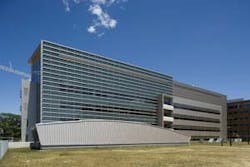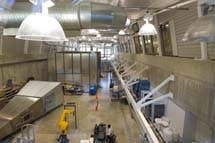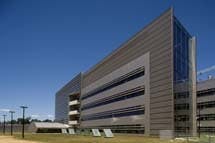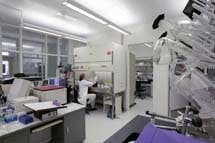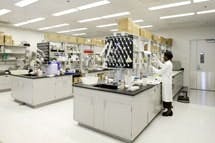Change Comes to Washington (and Maryland): FDA Consolidates in Silver Spring
The 3-million-square-foot campus, which is expected to cost $1.1 billion when complete and has won awards for architectural design and set new standards for energy efficiency, centralizes the Agency’s scientific laboratories and administrative offices.
Editor’s note: A collection of photos of the new facilities follows this article.
By all accounts, FDA is building partnerships with scientific and medical organizations, on both the global and the local level. Washington Adventist Hospital, for example, plans to relocate near the campus to collaborate on research and educational projects.
A visit to the White Oak campus in November found all visitor parking lots full and much construction still going on, since the final part of the project is expected to be completed next year.
The campus’ central shared-use building won a design award from the American Institute of Architects for a layout that maximizes sunlight and features open, interconnected spaces. Courtesy of KlingStubbins.
December saw the dedication of Building One, which houses executive offices, including that of the Commissioner. It joins two large office buildings, a shared-use facility that features libraries, conference rooms and a cafeteria, in addition to two laboratories where research is underway for the Center for Drug Evaluation and Research and the Center for Devices and Radiological Health.
The campus’ central shared-use building, designed along with other buildings by KlingStubbins, won a design award from the American Institute of Architects four years ago for a layout that maximizes use of sunlight and features open interconnected spaces.
Its facilities, meanwhile, have been designed to save $70 million in energy costs over the next two decades, and are being showcased as a Federal Energy Management success story by the U.S. Department of Energy (for more on this project, please visit PharmaManufacturing.com).
In 2007, the U.S. General Services Administration awarded Honeywell Building Systems $28.6 million in a 23-year contract to upgrade building systems and cut energy costs by $3 million per year. The facility’s design features solar panels and onsite turbine generators and chillers designed to capture and reuse waste heat and water.
A tour of the 128,000-foot CDRH Engineering and Physics laboratories revealed modern instrumentation, including an anechoic chamber, used to test RF and microwave, to block effects of echoes. One research project underway at the laboratories is evaluating the potential impacts of RFID within the industrial pharmaceutical plant.
If a single location and modern, well-equipped laboratories might suggest to some a stronger, more unified FDA and a commitment to improve the science underlying regulatory decisions, the campus’ stated goal, as articulated to the Federal Office of Management four years ago, is to attract world-class talent to the Agency, and to allow it to become more “citizen centered” by providing a single location where people can interact with the Agency.
The CDRH Engineering and Physics lab features an anechoic chamber that, among other things, is being used to test the potential impacts of RFID on drug production. Courtesy of KlingStubbins.
Now, the industry awaits to see who President Obama, who has pledged to make science-based policy a priority, will nominate to head FDA and HHS. A recent poll by blogger John Mack, publisher of the Pharma Marketing Blog, found Janet Woodcock, director of CDER, Cleveland Clinic cardiologist Steve Nissen, Wyeth and Pfizer whistleblower Peter Rost and Baltimore Health Department chief Joshua Sharfstein to be top contenders for the Commissioner post. A number of other names have also been mentioned in the news, including that of former Commissioner David Kessler, who recently resigned from his academic post.
Meanwhile, on the ground, FDA has launched a strong recruitment effort. Currently, 3000 employees work at the Silver Spring site, but, by 2012 that number is expected to rise to 8,000, according to von Eschenbach, who discussed the project on his audio program, “Andy’s Take”, on December 19. (You can find it on FDA.gov.) Agency leaders say they are continuing to work on global harmonization efforts through ICH (although it has not yet formally joined the global Pharmaceutical Inspectorate).
Last year, the Agency approved 24 NDAs, up 33% from the previous year, and set up offices in China, to help it better oversee operations.
Apart from food protection, the Agency’s top priorities for this year are:
- Pharmacovigilance, via activities stemming from the FDA Amendments Act of 2007 and the creation and implementation of Sentinel, an electronic system for monitoring medical product safety that will allow data to be accessed from health and medical claims records and facilitate remote data access.
- Import safety
- Partnerships with China to improve QA and QC efforts and strengthen sharing of information with agencies such as SFDA, China’s FDA-equivalent.
- GIVE, for Generic Initiative for Value and Efficiency, which would help streamline the generic drug approval process
Photographs of FDA’s Silver Spring Campus. All photos are courtesy of KlingStubbins.

